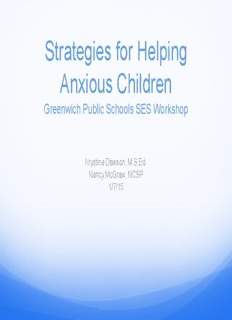
Strategies for Helping Anxious Children PDF
Preview Strategies for Helping Anxious Children
Strategies for Helping Anxious Children Greenwich Public Schools SES Workshop Krystina Dawson, M.S.Ed. Nancy McGraw, NCSP 1/7/15 Your brain is built to deal with stress that lasts about 30 seconds. The brain is not designed for long term stress when you feel like you have no control. The saber-toothed tiger ate you or you ran away but it was all over in less than a minute. If you have a bad boss, the saber-toothed tiger can be at your door for years, and you begin to deregulate. If you are in a bad marriage, the saber-toothed tiger can be in your bed for years, and the same thing occurs. Types of Anxiety ✧ GAD ✧ OCD ✧ Panic Disorder ✧ Separation Anxiety ✧ Social Anxiety ✧ Specific Phobias ✧ PTSD Generalized �Muscle tension ● Anxiety Disorder �Fatigue ● (GAD) �Restlessness ● Definition: when a person worries �Difficulty sleeping ● excessively about a variety of �Irritability ● everyday problems for at least 6 �Edginess months. ● Women 2x as likely as men to be �Chronic, ● affected; GAD affects 6/8 million unsubstantiated worry adults (3.1% of the U.S. pop.) Disorder comes on gradually; risk is highest between childhood and middle age http://www.nimh.nih.gov/health/publications/anxiety-disorders/index.shtml?rf=53414 and http://www.adaa.org/understanding-anxiety/generalized-anxiety-disorder-gad Obsessive- ● Obsessions Compulsive ● Frequent thoughts of Disorder violence ● Thoughts of harming Affects about 2.2 million American loved ones adults ● Thoughts prohibited by religious beliefs Both men and women impacted ● Preoccupation with order equally; usually appears in childhood, adolescence, or early and symmetry adulthood ● Pounding heart ● Sweatiness Panic Disorder ● Faintness ● Dizziness Characterized by sudden attacks of terror ● Weakness ● Chilled feeling Usually produce a sense of ● Tingling hands/numbness unreality, fear of losing control ● Nausea ● Chest pain Twice as common in women as men; attacks often begin in late ● Smothering sensations adolescence or early adulthood ● Fear of these previously experienced symptoms ≠ Panic attacks Panic Disorder from reoccurring http://www.nimh.nih.gov/health/publications/anxiety-disorders/index.shtml?rf=53414 Post Traumatic ● May startle easily Stress Disorder ● Emotionally numb (PTSD) ● Lose interest in things Develops after a terrifying they used to enjoy occurrence that involved physical harm or the threat of physical harm ● Difficulty feeling affection Traumatized person ≠ PTSD ● Irritability Symptoms must last >1 month ● Aggressive/violent behaviors Women are more likely to develop PTSD than men; affect approx. 7.7 million American adults ● Avoid reminders of the original incident http://www.nimh.nih.gov/health/publications/anxiety-disorders/index.shtml?rf=53414 Types of Phobias ● Agoraphobia (open spaces Specific Phobias ● Claustrophobia (tight Intense, irrational fear of something spaces) that poses little to no actual danger ● Bibliophobia (books) 2x more common in women than ● Germophobia (sicks) men; 19.2 million adult Americans affected ● Isolophobia (being alone) ● Enochlophobia (crowds) ● Laliophobia (speaking) ● Polyphobia (many things) ● Scolionophobia (school) http://www.nimh.nih.gov/health/publications/anxiety-disorders/index.shtml? rf=53414
Description: